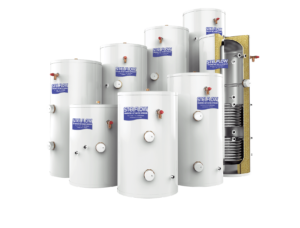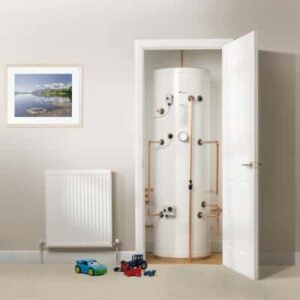Understanding Vented & Unvented Hot Water Cylinders
Hot water cylinders are extremely confusing.
In our 5-minute guide, we’ll explain:
- The difference between a vented and unvented hot water cylinder
- Which type of cylinder is best
- How big a hot water cylinder needs to be
Looking to see how much a vented or unvented hot water cylinder will cost to fit?
What Is A Unvented Hot Water Cylinder?
Unvented hot water cylinders don’t require a water storage tank. Instead, they’ll take water directly from the mains.
So, that makes this the ideal heating setup for those that want to use as little space as possible.
This can sometimes mean an improvement in pressure over a vented system. But, on the flip-side, if your mains water pressure is low, your hot water output is going to be affected.
As an unvented hot water cylinder heats up water, pressure builds.
An expansion vessel allows this pressure to escape, so will need to be fitted alongside the unvented cylinder. This works alongside a pressure release valve and is a fail-safe for when hot water gets above its desired temperature.
The two ways to heat up the water are:
- Using an immersion heater
- Using the central heating
What is a Vented Hot Water Cylinder?
A vented hot water cylinder is common in older properties. The system relies on a water storage tank, and you’ll usually find this fitted in the loft space.
Vented systems are known as “gravity fed hot water systems”, and that’s why if you have a reasonable mains water pressure, you’ll benefit from an unvented system instead.
Instead of an expansion vessel, a vented hot water system will allow pressure to be released into the water storage tank.
Essentially, the water storage tank is the equivalent of the expansion vessel. So, it’s certainly a little more basic than an unvented system.
Should You Buy A Vented Or Unvented Hot Water Cylinder?
Now you know the difference between an unvented and vented hot water system.
But, what are the benefits and drawbacks of each?
Which one is the best?
 Well first, take our look at our cost guide to hot water cylinder installation.
Well first, take our look at our cost guide to hot water cylinder installation.
Essentially, vented systems are cheaper than unvented systems.
Vented Heating Systems
Vented hot water cylinder installations are cheap. And, that’s because they are basic.
Usually, a vented installation will only be the preferred option, if the property owner doesn’t want to pay for an upgrade to an unvented system.
But remember, vented hot water systems rarely deliver hot water at the pressure of a unvented system, and take up extra space due to the additional water storage tank that they require.
Who Is A Vented Hot Water Cylinder Suitable For?
- Low installation and maintenance budget
- Happy with pressure from a gravity fed system
- Currently have a vented system installed, and don’t want to pay for an upgrade
- Have space for a cold water storage tank
Unvented Heating Systems
You’ll be saving space, due to not needing a hot water storage tank. And, as this isn’t a gravity fed system, it’s likely you’ll have additional hot water pressure.
The biggest drawback of an unvented system is the cost. If you have a vented system fitted, you’ll pay extra to upgrade to an unvented system. And, unvented cylinders do tend to be more expensive.
Who Is An Unented Hot Water Cylinder Suitable For?
- Happy with the slightly higher installation and maintenance cost
- Needs high hot water pressure
- Has high mains water pressure
How Big Does A Hot Water Cylinder Need To Be?
We’ve created a hot water cylinder sizing guide here. But, this is a general guideline for the capacity you need from your cylinder.
| Property Size | Bathrooms | Cylinder Size |
| 1 Bedroom | 1 | 120-150L |
| 2 Bedrooms | 1 | 150-180L |
| 3 Bedrooms | 1 or 2 | 180-210L |
| 4 Bedrooms | 2 | 210-300L |
| 5 Bedrooms or more | 2 | 300L or bigger |
What’s Next?
Have any questions about vented or unvented cylinders? Leave a comment below and we’ll get back to you.
